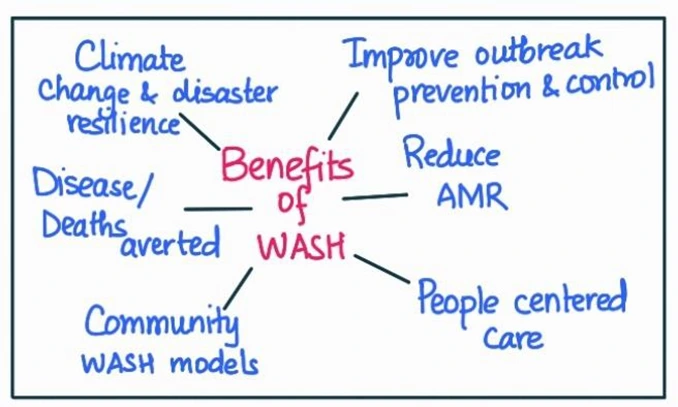Answer:
| Approach:
Introduction
- Introduce the WASH scheme and its objectives.
Body
Divide the body into four main sections:
- Identification of beneficiary segments:
- Focus on vulnerable and marginalized populations.
- Address the specific needs of these groups.
- Anticipated outcomes:
- Reducing waterborne diseases.
- Enhancing access to clean water and sanitation facilities.
- Promoting healthy hygiene practices.
- Synchronization of beneficiary identification and outcomes:
- Targeted interventions.
- Efficient resource allocation.
- Improved monitoring and evaluation.
- Collaboration with stakeholders:
- Involvement of local governments, NGOs, community-based organizations, and the private sector.
- Addressing needs and achieving anticipated outcomes.
Conclusion
- Write a relevant conclusion.
|
Introduction:
The Water, Sanitation, and Hygiene (WASH) scheme aims to improve public health and well-being by providing access to clean water, adequate sanitation facilities, and promoting good hygiene practices. Ensuring effective implementation of policies addressing WASH needs requires synchronizing the identification of beneficiary segments with the anticipated outcomes.

Body:
The WASH scheme involves the following aspects:
- Identification of beneficiary segments:
- Identifying the most vulnerable and marginalized populations, such as those living in remote rural areas, urban slums, or areas with high poverty rates, is crucial.
- These groups often have limited access to WASH facilities and are more susceptible to waterborne diseases and poor hygiene-related health issues.
- Focusing on these segments allows the WASH scheme to significantly impact overall health and well-being.
- Anticipated outcomes:
- The primary objectives of the WASH scheme include reducing waterborne diseases, enhancing access to clean water and sanitation facilities, and promoting healthy hygiene practices.
- Achieving these outcomes requires interventions directly addressing the needs of the identified beneficiary segments, such as constructing and maintaining water supply systems, building toilets and sanitation facilities, and promoting behavioral change through hygiene education and community engagement.
- Synchronization of beneficiary identification and outcomes:
- Aligning the identification of beneficiary segments with the anticipated outcomes ensures that resources are effectively allocated to areas of greatest need.
- This synchronization also enables better monitoring and evaluation of the scheme’s impact, allowing for necessary adjustments and improvements in program implementation.
- Collaboration with stakeholders:
- Successful implementation of WASH policies involves various stakeholders, including local governments, NGOs, community-based organizations, and the private sector.
- This collaborative approach ensures that the needs of the identified beneficiary segments are adequately addressed, and the anticipated outcomes are achieved.
Conclusion:
Synchronizing beneficiary identification with anticipated outcomes in the WASH scheme is crucial for effective implementation. This approach ensures targeted interventions, efficient resource use, and the achievement of desired impacts, ultimately enhancing the well-being of vulnerable and marginalized populations.
